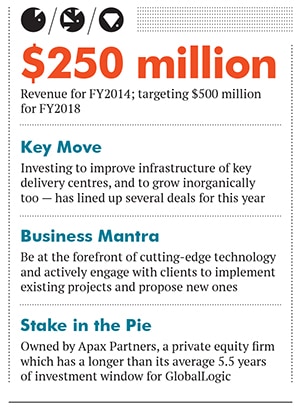
GlobalLogic: Outsourcing Champions
An outsourced product developer, born in Silicon Valley, is enjoying rapid growth in quick time
On the one side we help develop products that are life-saving, and, on the other, we help develop products that make life comfortable.” This is how Shashank Samant, CEO of GlobalLogic, describes his Silicon Valley-based company that helps develop medical devices—pacemakers and tools to check blood sugar levels—for medical technology firms such as Medtronic, as well as analyse data for internet giants like Google.
In industry jargon, GlobalLogic specialises in outsourced product development (OPD) and focuses on R&D services. That is why, says Samant, the company is different from typical IT services or BPO companies. “We don’t do anything and everything for everybody. We work at the core of technology,” he says. GlobalLogic caters to companies working in the areas of high technology, communications and media, medical devices and automotives.
Founded in 2000 by four friends—Rajul Garg, Manoj Agarwala, Sanjay Singh and Tarun Upadhyay—the company was then called IndusLogic. Although it had its corporate headquarters in Virginia, US, its biggest delivery base was in India. After seven acquisitions (after one such acquisition in 2006, the company changed its name to GlobalLogic), India remains the largest, with 4,600 of its 8,000 engineers. Its other major delivery bases are in Eastern Europe and South America. The US, however, is home to 70 percent of its clients.
The four founders had long moved out (selling stakes to private equity players New Enterprise Associates, Sequoia Capital, Westbridge Capital, Goldman Sachs, and New Atlantic Ventures) when Apax Partners, a UK-based private equity and venture capital firm, bought over the company in late 2013. “We were impressed with Samant’s team and the global delivery model it had developed,” says Shashank Singh, partner and head of Apax’s India office. Singh and his team tracked GlobalLogic for three years before acquiring it.
The man behind it
After stints at IBM, HP and NESS Technologies, Samant joined GlobalLogic as president in 2008 and became CEO in 2012, taking over from Peter Harrison who became vice chairman.
In the six years since he joined, the company’s revenues grew from $50 million to $250 million (FY2014). GlobalLogic, Samant adds, has been profitable for seven years and has an Ebidta (earnings before interest, depreciation, tax and amortisation) margin of 20 percent.
With technology at its core, the company realises the significance of understanding engineering to appreciate the business. Therefore, it is a requirement that each of its top executives, even those heading marketing functions, is an engineer. It is for the same reason that human resource functions are localised.
Where the organisation’s structure is concerned, Samant introduced the concept of a unified product delivery lab. “Earlier, the labs were structured according to the industry they were catering to and were operating in silos,” says A Nandini, vice president and head of the Noida delivery unit. Integrating the labs—they are spread across regions but structured under a single unit and headed by a person in Virginia—has helped GlobalLogic cross-leverage talent and stay updated with the latest in technology.

Why it is a gem
As he was looking for a prospective deal, Apax’s Singh was more interested in the OPD space compared to the IT services or BPO sectors. “It is very difficult to break into the tier-1 of IT services, with the likes of TCS [dominating it]. The BPO sector’s growth has slowed a bit. The OPD space is the youngest of all the sectors and is growing the fastest,” he says.
In the early 2000s, a McKinsey study had predicted the OPD segment will be worth $3 billion in 10 years. Today it is worth $7.5 billion, according to a study by Booz, says Samant. “And it is growing at a rate of 15 to 20 percent,” he adds.
This rapid growth is a fallout of the speed at which technology companies are being pushed to come up with new products; thanks to competition, they are at times required to introduce new products in weeks. Earlier, companies like SAP produced a new product once in 10 years. “Today it has shortened to months and even weeks, as in the case of LinkedIn or Google,” says Samant. Moreover, companies have to deal with more than one technology trend at a time, therefore being forced to outsource more and more of their R&D to companies like GlobalLogic.
Why was it hidden
When it comes to visibility, Samant equates GlobalLogic with 3M (known for its car care products) and Bosch (the German company that makes automobile parts). “You never know that your car polish comes from 3M. It is the same for us,” he says.
Moreover, no company in the OPD segment has attained a scale similar to a tier-1 IT services company. There are some companies who have revenues between $200 million and $300 million, including GlobalLogic. Singh has bet on the company to be among the earliest to break free and reach the $1 billion mark; this is also one reason why Apax is willing to wait longer than its average five-and-a-half years of investment window for GlobalLogic. One of options that will be considered is a listing in the US.
Risks and challenges
Samant realises that managing GlobalLogic’s huge talent pool is one of his biggest challenges.
Singh adds that the other challenge would be execution, given the ambitious revenue target of the top team. GlobalLogic also operates in a fast-changing industry and it has to innovate constantly to remain relevant. And, points out Singh, “your USP has to remain relevant”.
(This story appears in the 30 November, -0001 issue of Forbes India. To visit our Archives, click here.)





